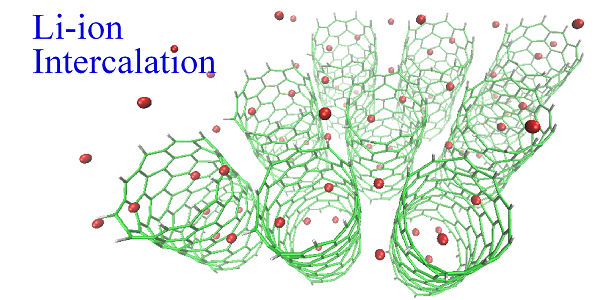






A key energy challenge in this century is the storage of electrical energy with a high charge-and-discharge rate, high capacity, and high cyclability.The carbon nanotube (CNT)-based Li-ion battery is believed to be one of the most promising electrochemical energy storage systems/devices. The illumination of the mechanism on Li ions intercalating and diffusing in CNT-based structure will greatly promote the development and application of the Li-based energy storage device.

Recently, Bo Song, Haiping Fang et al. from Shanghai Institute of Applied Physics, Chinese Academy of Sciences, have studied the intercalation and diffusion of lithium ions in a bundle of carbon nanotubes, by taking advantage of recent developments in computer facilities and in particular the ab initio MD method based on density functional theory. Their work is published on the journal of “Energy & Environmental Science” [Energy Environ. Sci. 4, 1379 (2011)]
In the paper, they presented the first direct observation of Li ions intercalating and diffusing dynamically in CNT bundle via applying the latest ab initio molecular-dynamics technique. Especially, it was found that Li ions located between three neighboring CNTs were very difficult to remove from a bundle of nanotubes. This indicated that the intercalation of lithium between three neighboring CNTs might irreversible in a charge-discharge process, which would reduce the effective capacity of the energy storage. Further investigation showed that the distance between the nanotubes played a key role in the stability of the intercalating ions. Thus, they predicted that a reasonable control of the distance between nanotubes could efficiently promote the reversible capacity and the charge-discharge rate of CNT-based devices toward super energy storage. Their findings contribute to the understanding of lithium intercalation and diffusion in CNTs, which has useful implications for the experimental development and application of rechargeable Li ion batteries. Additionally, the ab initio molecular dynamics technique applied in this work is a hopeful approach in the field of nano-materials.
This study is based on the collaboration of the researchers from Shanghai Institute of Applied Physics (Chinese Academy of Sciences), Sichuan University, and Dalian University of Technology. It is supported by Chinese Academy of Sciences, National Natural Science Foundation of China, Ministry of Science and Technology of the People’s Republic of China, and Shanghai Supercomputer Center.